Introduction
This article focuses on the relationship between start-ups and business performance as their primary durability factor. The two concepts are interconnected in the literature, especially because of the need for a fair assessment of the evolution of companies at the start of their journey. For start-ups, business sustainability is the most important factor to consider as a result of its own performance (Koyagialo, 2016), as corporate sustainability leads to a drop in the reliance on governmental financing by achieving economic independence and by creating a market where financial transactions can be conducted in a consistent and stable manner (Wallace, 2005).
The development of small businesses, including start-ups, is a current topic in the European context. The revival of entrepreneurship was a must after the 2008 economic crisis. Thus, the interest toward the development of small businesses has been addressed at European level since 2013 in the “Entrepreneurship 2020 Action Plan”. The need for an SME development policy adjusted to the economic context has been addressed by the review of the Small Business Act for Europe. This initiative is the European Commission’s way to recognize the central role of small and medium-sized enterprises (SMEs) in the EU economy by establishing a comprehensive political framework for 99% of all European businesses.
Business performance is both profitability, as a short-term shareholding objective, and sustainability, as a multiplier factor for the investment made. The performance concept was defined by Ristea (1997) as a sum of economic efficiency, efficiency and effectiveness. Also, Kaplan and Norton (1996) considered that performance is a balanced set of perspectives covering financial and internal aspects, customer issues, as well as the framework for business learning and development.
Since 2000, the development of start-ups has been steadily expanding, as the Governments of most countries worldwide encourage them, both through the application of advantageous legislative packages and through direct financial support. This means that in 2018, direct investments of USD 99.50 billion were made in US-based start-ups alone, 30% more than in 2017. Leaders in their fields, companies such as Google, Facebook, Uber, Airbnb, Dropbox or Xiaomi, were start-ups at the beginning, managing in a short period to increase the value of their companies by tens of billions of dollars. This ecosystem of start-up companies plays an especially important role in the self-employment for entrepreneurs, but also in creating new jobs.
Given their importance in terms of their number, small and medium-sized enterprises representing 95% of the companies in the OECD countries, and, also the creation of around 60 to 70% of the new jobs (Mayer-Haug, 2013), special attention must be paid to business performance and thus to their sustainability.
The relationship between the “start-up” – “business performance” concepts is thus becoming a determining factor for the global economic stability, particularly considering the relationship between these concepts and the need for careful monitoring of the business ecosystem’s evolution.
The paper is structured in five chapters: introduction, subject approaches in literature, research methodology and data collection, analysis of the results obtained and conclusions.
The main purpose of this Article is to guide new researchers in the analysis of start-ups and business performance thereof, with regard to literature and reference authors in the field.
Research Methodology And Data Collection
This research takes into account in what manner the relationship between “start-up” and “business performance” concepts is reflected in the literature between 1981 and 2020.
A start-up can be defined as a project-based organization or company in a variety of business areas that applies a new development model by combining innovative ideas or advanced technologies and seeks, through its activity, to enter new markets.
In general, “business performance” can be objectively defined by measuring some balance sheet financial indicators such as profit, turnover, or total assets. For start-ups, performance can be extended to the success of remaining on the market, in stabilizing the course of action and having the opportunity to identify new development paths. This also provides a different approach to start-ups, the most important factor to be taken into account in relation to them being the sustainability of the business (Koyagialo, 2016).
Regarding the data collection process for the research and the selection of articles for the bibliometric analysis, these were collected through key terms research of the Web of Science database provided by Clarivate Analytics. This database was chosen due to its international recognition and the trust it enjoys as one of the most recognized multidisciplinary research platforms.
Bibliometrics represents a statistical analysis of books, articles, or other publications (OECD Frascati Manual, 2013). Initially, the activity was limited to collecting data on the number of scientific articles and publications, classified by authors and/or by institutions, scientific fields, countries, in order to build simple “productivity” indicators for academic research. Later, more sophisticated, and multi-dimensional techniques based on article quotations were developed. The results of their quotations and analyses are used to increase the quality of research and to track the development of the fields of science and networks.
The present bibliometric analysis research is focused on the key words „start-up*” and „business performance”. This analysis uses data on numbers and authors of scientific publications and articles and their quotations in order to measure the “outcome” of research teams, institutions and countries, to identify national and international networks and to map the development of new (multidisciplinary) areas of science and technology.
The first step in the bibliometric research is the search of the key notions that are the central part of the analysis, namely „start-up*” and „business performance”. The search was finalized between January-February 2021 and it used the „Article title” search criteria on the Web of Science database which returned a total number of 940 publications over the 40 years period chosen for the analysis, specifically between 1981 and 2020. Publications from 2021 were removed from this analysis and considered irrelevant due to the fact that the year 2021 is incomplete.
In order to acquire a comprehensive picture in terms of analysis, the research included the evolution of publications that approached both concepts, as well as their individual evolution. Thus, the „start-up” keyword was identified in 3.573 publications, whilst „business performance” was identified in 3.541 publications. The next step consisted of researching the number of authors that published papers on the analysed keywords, with the search highlighting a number of 2.135 authors on the platform.
In addition, through the Web of Science (WoS) database, the research identified the languages of the 940 papers’ publications included in the present analysis, along with the countries where the authors have published their research papers/articles. The last stage of the research was reserved/ dedicated to analysing the journals in which the authors have published their research.
The results are presented in detail in the following chapter.
Analysis Of Obtained Results
According to the database’s analysis with the 940 publications, the correlation between the two analysed concepts, “start-up” and “business performance”, entered the literature early in 1981, but failed to develop consistently until 2003, when a series of 12 works that met the studied condition were observed. Thus, as shown in Fig. 1 – Evolution of publications/years in the first 20 years of the 40 years considered in this study, only 41 publications representing 0.04% of the total 940 results are actually fulfilling the correlation.
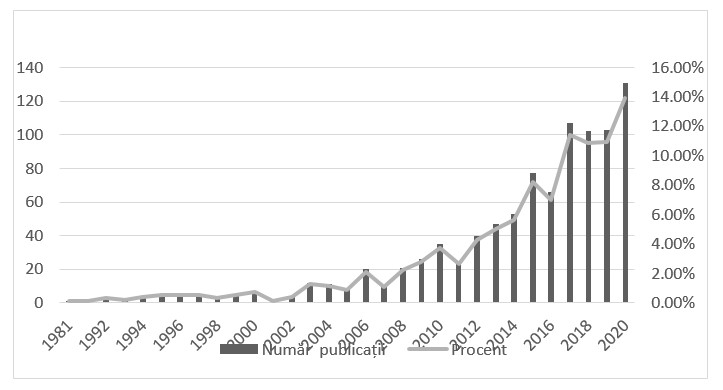
Fig.1: Evolution of publications/years
Source: Clarivate Analytics, Web of Science (2021)
By analysing in detail the evolution of the two concepts, this time separately, without correlation, we have identified that between 1981 and 2000 none of them were of interest to the researchers, with a similar situation in literature. Thus, the concept of “start-up” was identified in 3,573 works, representing 13.41% of the total of 26,653 published between 1981 and 2020, while “business performance” was identified in 3,541 works, representing 5.08% of the total of 69,667 published in the same period.
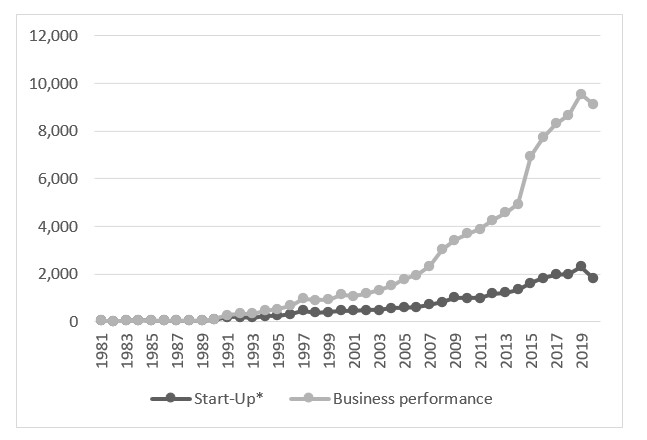
Fig. 2 – Evolution of the “start-up” and “business performance” concepts in literature from 1981 to 2020
Source: Clarivate Analytics, Web of Science (2021)
There are 2,135 authors who have published at least one work including the correlation between “start-up” and “business performance”, however only 8 of them have published between 5 and 8 works on the topic, according to Table 1.
Table 1 – Structure of the number of authors in relation to the number of articles published
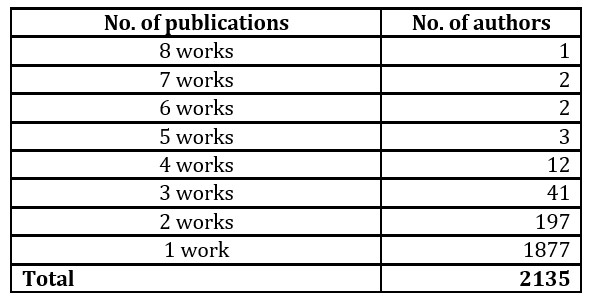
Source: Clarivate Analytics, Web of Science (2021)
As shown in Table 2, the author of most of the works is Michael Wright, a Member of the British Academy and a professor of entrepreneurship at the Imperial College Business School, London, followed by Oswald Jones, an emeritus professor of entrepreneurship at the University of Liverpool and by Frank van Rijnsoever, Associate professor of Innovation studies, University of Utrecht.
Table 2 – Distribution of the most published authors

Source: Clarivate Analytics, Web of Science (2021)
Most of the published studies are articles, with a share of 80.74%, followed by 12.47% works and 4.36% reviews.
A worldwide analysis, according to the graphic in Fig. 3, reveals that the published works are written by authors from 85 states. The research leader of the two related concepts is the United States of America, with 14.88%, followed by the United Kingdom with 8.94% and Germany with 7.89%. The European Union, which is present in the international rankings through 24 countries, has a research interest of 42% of the total works produced.
98.09% of the works were produced in English, 4 works in French and Spanish, representing 0.85%, and the difference of around 1% of the works was in German, Portuguese, Russian, Chinese, Croatian, Danish and Hungarian.
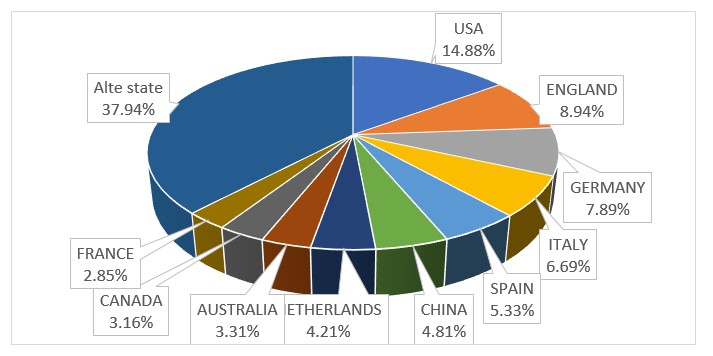
Fig. 3 – Distribution of the number of works worldwide
Source: Clarivate Analytics, Web of Science (2021)
By analysing the information on the Web of Science, about 24% of the 940 works can be found in the publications in Table 3, while the 716 works representing about 76% are contained in 490 publications.
Table 3 – Distribution of analysed works in publications
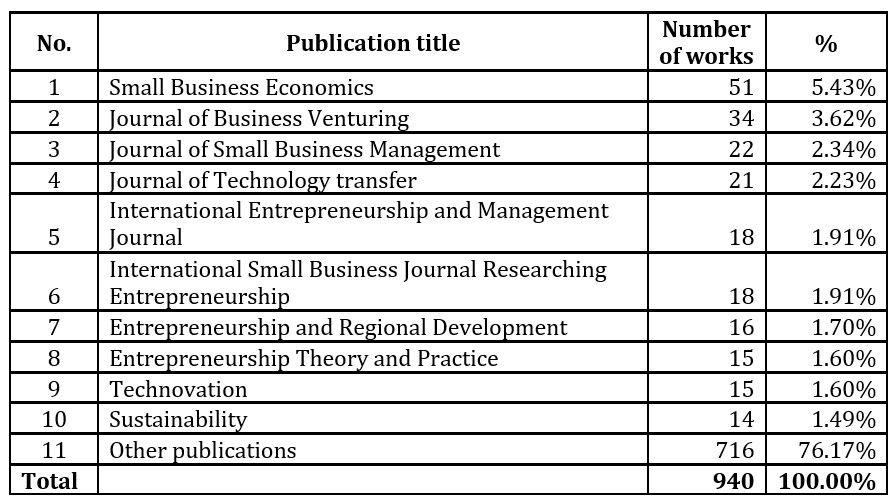
Source: Clarivate Analytics, Web of Science (2021)
Discussions
Relevant for this research is the fact that studies that include the correlation between “start-up” and “business performance” are heterogeneous, suggesting that the different approaches have developed in an isolated manner, in line with authors’ reviews or research topics. The possible explanations for the heterogeneity of studies can be based on both the lack of concepts of foundation and on the extent and complexity of the two concepts, in terms of business sustainability. This lack of clarity in the joint association of the two concepts clearly requires a unified concept and research area, which will offer to the specialist literature a broader capacity to propose practical input and analysis models for the sustainability concept of start-up business.
By analysing the relationship between the two concepts, “start-up” and “business performance”, according to the bibliometric indicators presented above, the increased need to develop new research has emerged, as the interdependency of the two factors generates added value in the economy, thus requiring greater attention from start-up owners, but also from governments. The social impact of this contingency is becoming multidimensional and can take the form of technological progress, increased efficiency and effectiveness of investment, and a range of social objectives being achieved by state governments. The main attribute of the start-up concept is, undoubtedly, the innovation, but this cannot develop sufficiently beyond the cooperation in business initiatives such as incubators, science parks, clusters or hubs. Thus, the literature focused on investigating how cooperation generates added value to the business, which is prevalent in investor-centered innovation contexts (Payne et al., 2007; Lakhani & von Hippel, 2003), communities/virtual platforms (Fuller et al., 2011) and multidisciplinary projects (Ahn et al., 2015).
The approach based on bibliometric techniques and the symbiotic analysis of the two concepts give additional nuances of understanding of the research dynamic and its historical perspective, but the result converges towards the conclusion that research areas are often structured differently, without a distinct conceptual approach, but which are complementary to the literature on innovation and entrepreneurship.
The key role in linking “start-up” and “business performance” is the entrepreneur and the vision it puts into practice, studies indicating that entrepreneurs are action-oriented and learning is often experimental (Rae and Carswell, 2000), the mental model including their knowledge, experience and beliefs (Cope, 2003). The literature identifies close links between human capital (education and experience), social capital creation and entrepreneurial learning. The human capital theory is based on the idea that the development of cognitive capacity leads to higher levels of productivity and efficiency (Davidsson and Honig, 2003), while incorporating the experience and experimental learning, as well as the formal education (Becker, 1964). It was also noted that entrepreneurship education can be an important tool to encourage entrepreneurship based on opportunities, reducing the chances of failure (Verheul, 2010).
Another key factor in the sustainability of start-ups is the regional economic environment directly linked to the regional innovation activity, the regional employment growth and the population density (Fritsch, 2006). While regional factors have an important effect on the survival of new businesses, entrepreneurs face the decision of choosing the right location for their start-up, with empirical research highlighting that start-ups are almost always set up close to the entrepreneur’s home (Mueller and Morgan, 1962; Sorensen and Audia, 2000).
The intensity of competition has nowadays become one of the decisive factors for keeping a business on the market, for identifying and attracting customers and, eventually, for increasing the economic performance. As Marco van Gelderen said, “the first success of a firm is its birth” (Gelderen, 2005), then the chances of the new firms to survive are also given by the intensity of competition in the market in which they operate, trends being changed from the competition for the natural resources to the competition for active knowledge in the field of activity. As start-ups are constrained by resources and depend on the innovative combination of internal knowledge, they may initially enjoy a competitive advantage over old firms, which rely on traditional development methods.
In this context, the broad-based research and the development of the business sustainability concept could integrate analysis criteria that contribute directly to the literature, as well as to the basis of analyses and business decisions. The need for research supports the business environment that faces an unprecedented and complex variety of requirements (environmental, market, technological and social) needing sophisticated management based on sustainability. Integrated sustainability efforts clearly lead to a positive impact on business performance, therefore the foundation of sustainable business benchmark and designing a model for the sustainability analysis of a business will generate an added value for the entire society. The concept and sustainability analysis model of a business will implicitly lead to the development of risk management tools and can also lead to innovation.
Conclusions
This article presents a bibliometric analysis by exclusively using the Web of Science database to determine the research areas with the greatest concentrations on the correlation analysis of two basic concepts for global economic progress: “start-up” and “business performance”. The analysis has clearly and unequivocally revealed that this interconnection of elements is on the upward trend in the interest of researchers over the last 10 years, with an accelerated course over the last 4 years. The main areas of development are the European Union, the United States of America and the United Kingdom, English being the main publication language for this works. However, the heterogeneity of the studies and research is also taken into consideration, which makes it necessary to develop cumulative studies and innovative references within a conceptual reference framework.
In terms of research limitations, these may be derived from the fact that the analysis has included a single international database from which reference works on the correlation between “start-up” and “business performance” may be lacking.
The key factors for further research in this area result from the need to extend global support for start-ups. The issue of innovation in the business environment is becoming increasingly important considering the current structural changes, and without stimulating this process and without helping modern business support structures (incubators, science parks, clusters, hubs), the performance of businesses will not be able to align effectively with the Community market. In conjunction with this aspect, the digitalization of the business environment, the automation and the implementation of modern management tools are becoming essential for the efficiency and performance of businesses in the globalized market.
In a synthetic concept, the durability of a start-up is achieved when the business can survive and prosper successfully, and the people involved in the business, together with the processes and procedures, are in a state of symbiosis to survive in the long term. And, in order to examine, to follow and to make informed decisions based on the longevity of a business, there is a need for elaborate research and a scalable analysis model that measures the relationship between a company’s strategic behaviour, financial performance and sustainability, items that are intrinsically aligned with the long-term interests of the company.
Acknowledgements
This survey is the result of research carried out within the PhD programs of the University of Economic Studies in Bucharest, the Doctoral School of Management.
References
- Ahn, J.M., Minshall, T., and Mortara, L. (2015) Open innovation: a new classification and its impact on firm performance in innovative SMEs. Journal of Innovation Management, 2, November, 33–54.
- Becker, G. (1964) Human Capital. New York: National Bureau of Economics.
- Cope, J. (2003) ‘Entrepreneurial Learning and Critical Reflection: Discontinuous Events as Triggers for Higher-level Learning’, Management Learning 34(4) 429–50.
- Davidsson, P. and Honig, B. (2003) ‘The Role of Social and Human Capital among Nascent Entrepreneurs’, Journal of Business Venturing 18(3): 301–31
- Fritsch, M. (2006) “The Effect of Industry, Region, and Time on New Business Survival – A Multi-Dimensional Analysis”, Review of Industrial Organization (2006) 28:285–306.
- Fuller, J., Hutter, K., and Faullant, R. (2011) Why co-creation experience matters? Creative experience and its impact on the quantity and quality of creative contributions. R&D Management, 41 (3), 259–273
- van Gelderen, M, Success and Risk Factors in the Pre-Startup Phase Small Business Economics (2005) 24: 365–380
- Kaplan, R.S. and Norton, D.P. (1996), “Linking the balanced scorecard to strategy (reprinted from the balanced scorecard)”, California Management Review, Vol. 39 No. 1, pp. 53-79.
- Koyagialo, K.F. Small Business Survivability beyond FiveYears. Ph.D. Thesis,Walden University, Minneapolis, MN, USA, July 2016.
- Koyagialo, K.F., Small Business Survivability beyond Five Years. Ph.D. Thesis, Walden University, Minneapolis, MN, USA, July 2016.
- Krueger, N.F.; Carsrud, A.L. Entrepreneurial intentions: Applying the theory of planned behavior. Entrep. Reg. Dev. 1993, 5, 315–330.
- Lakhani, K. and von Hippel, E. (2003) How open source software works: free user-to-user assistance. Research Policy, 32, 6, 923–943.
- Mayer-Haug, K.; Read, S.; Brinckmann, J.; Dew, N.; Grichnik, D. Entrepreneurial talent and venture performance: A meta-analytic investigation of SMEs. Res. Policy 2013, 42, 1251–1273
- Mueller, E., and J. N. Morgan (1962) ‘Location Decisions of Manufacturers’, American Economic Review 52, 204–217.
- OECD Frascati Manual, Sixth edition, 2002, Annex 7, paras. 20-22, page 203, Oxford Dictionaries, 2013, website.
- Payne, A.F., Storbacka, K., and Frow, P. (2007) Managing the co-creation of value. Journal of the Academy of Marketing Science, 36, 1, 83–96.
- Rae, D. and Carswell, M. (2000) ‘Using a Life-Story Approach in Researching Entrepreneurial Learning: The Development of a Conceptual Model and its Implications in the Design of Learning Experiences’, Education & Training 42(4–5): 220–7.
- Ristea, Mihai “Contabilitatea rezultatului întreprinderii”, Ed. Tribuna Economica, Bucuresti, 1997
- Sorensen, O., and P. G. Audia (2000) ‘The Social Structure of Entrepreneurial Activity: Geographic Concentration of Footwear Production in the United States 1940–1989’, American Journal of Sociology 106, 224–262
- Verheul, I., Thurik, R., Hessels J., and van der Zwan P., Factors Influencing the Entrepreneurial Engagement of Opportunity and Necessity Entrepreneurs, Eurasian Economic Review, Jan. 2010
- Wallace, B. Exploring the meaning(s) of sustainability for community-based social entrepreneurs. Soc. Enterp. J. 2005, 1, 77–89.








